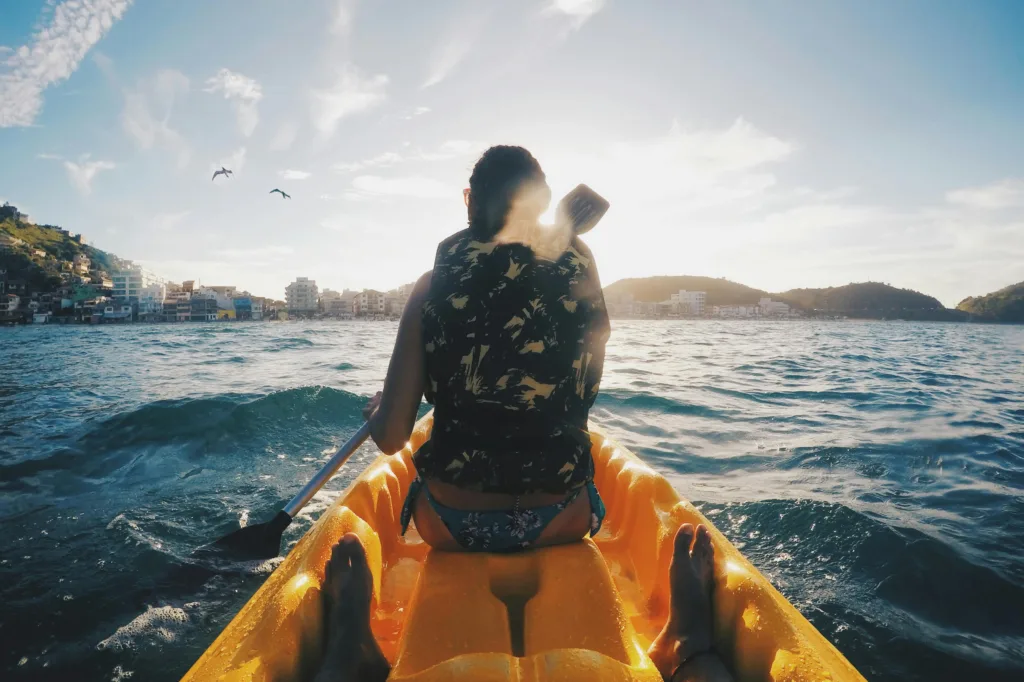Table of Contents
Introduction to Kayaking
Kayaking is more than just a sport; it’s a journey into the heart of nature, offering unparalleled experiences of freedom, adventure, and tranquility. Whether you’re gliding through serene lakes, navigating the twists of a rushing river, or exploring the vastness of the sea, kayaking connects you with the water in an intimate and exhilarating way. This blog post delves into what is kayaking, its myriad benefits, essential gear, and how you can start your paddling adventures. So, grab your paddle as we embark on this journey to understand why kayaking has captivated the hearts of millions worldwide.
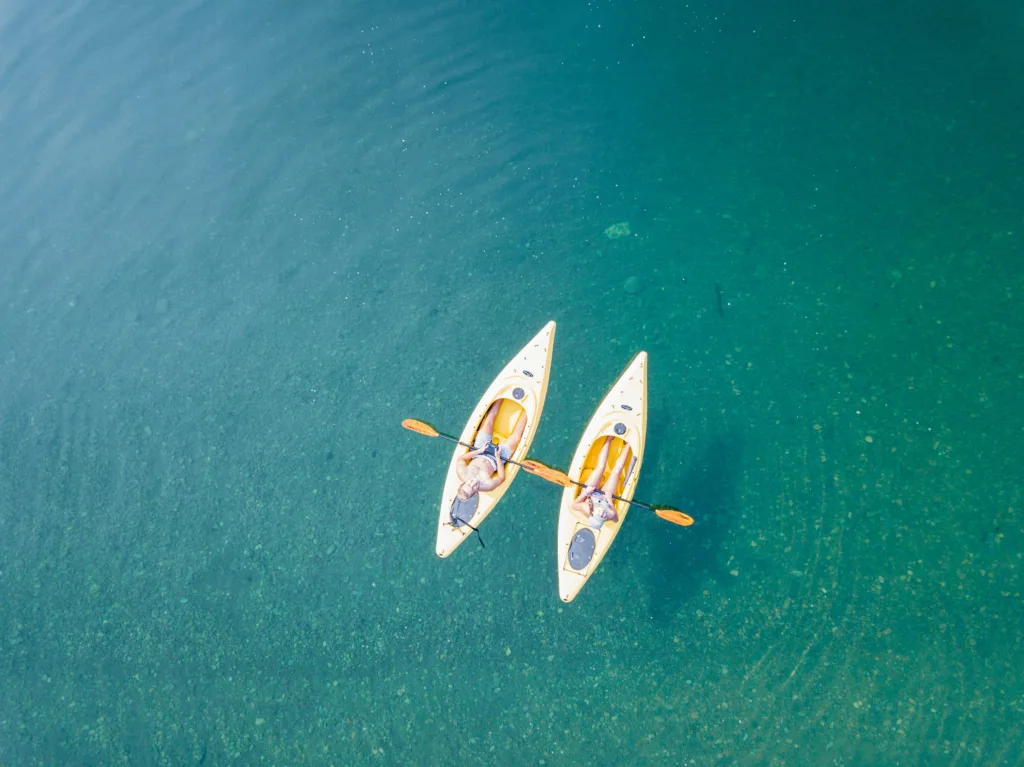
What is Kayaking?
Kayaking is a versatile and thrilling water sport that involves using a kayak, a small, narrow watercraft propelled by a double-bladed paddle. The origins of kayaking trace back thousands of years to the Inuit and Aleut tribes of the Arctic North America, who crafted these vessels from animal skins stretched over wood or whalebone frames for hunting. Today, kayaking has evolved into a popular recreational and competitive activity that caters to various interests and skill levels, including sea kayaking, whitewater kayaking, and recreational kayaking.
Each type of kayaking offers a unique experience. Sea kayaking involves paddling on open waters, exploring coastlines, and often navigating through waves and currents. Whitewater kayaking is more adrenaline-pumping, requiring navigation through fast-moving rivers and rapids. Recreational kayaking, the most accessible form, is perfect for beginners and those looking for a relaxing way to enjoy scenic waterways without the technical challenges of the other types.
Kayaking not only provides a physical workout but also offers a serene escape from the daily grind, allowing paddlers to immerse themselves in the natural beauty and tranquility of water environments. Whether it’s the peaceful solitude of a lake at dawn or the exhilarating challenge of a river rapid, kayaking adapts to fit the desires of every adventurer.
Understanding what kayaking entails is the first step towards embracing this incredible sport. With its rich history, diverse styles, and the ability to connect deeply with nature, kayaking invites enthusiasts of all levels to explore the world’s waters in a way that is both intimate and adventurous.
The Benefits of Kayaking
What is kayaking if not a holistic activity that nurtures both body and mind? The benefits of kayaking are vast and varied, touching upon physical health, mental well-being, and emotional fulfillment.
Physically, kayaking is an excellent workout. It strengthens the core and improves cardiovascular health, tones the upper body, and enhances flexibility and balance. The rhythmic nature of paddling also offers a low-impact exercise option, making it accessible for people of varying fitness levels and ages.
Mentally, kayaking acts as a stress reliever and mood booster. The combination of physical activity, outdoor exposure, and the soothing sounds of water contribute to a significant reduction in stress and anxiety levels. It promotes mindfulness and present-moment awareness, often leading to a meditative state that fosters a sense of peace and contentment.
Additionally, kayaking offers a unique opportunity to connect with nature. It allows paddlers to access remote waterways, witness wildlife up close, and experience the tranquility and beauty of natural landscapes from a new perspective. This connection with the environment not only enhances one’s appreciation for the natural world but also underscores the importance of conserving these precious ecosystems.
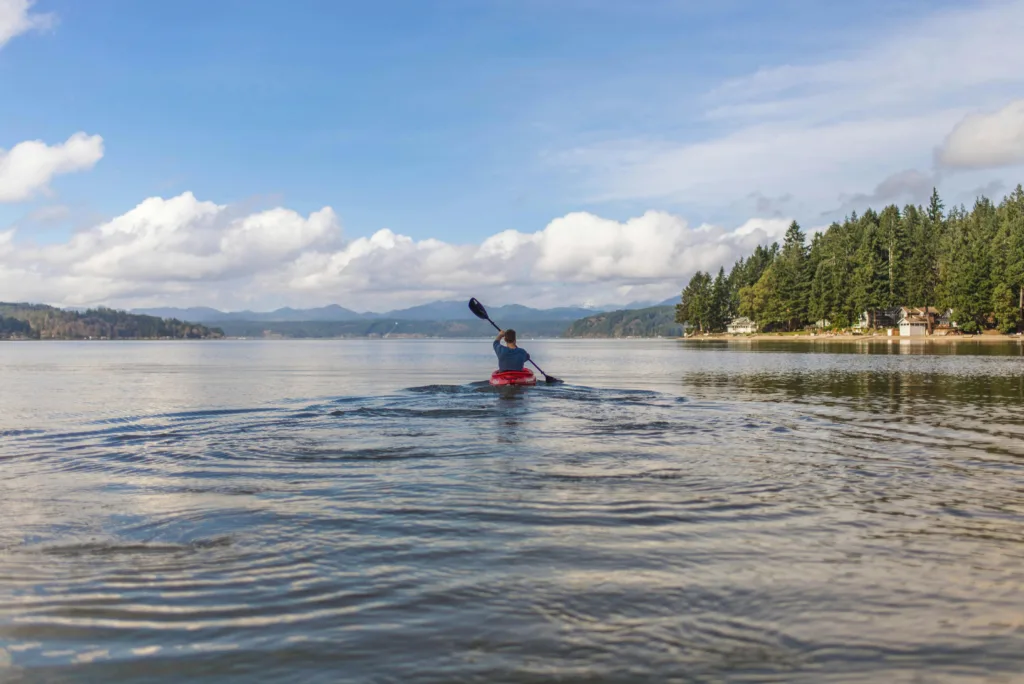
Essential Gear for Kayaking
Embarking on a kayaking adventure requires more than just a kayak and a paddle; the right gear is essential for safety and comfort. The basics include:
- Kayak: Choosing the right kayak depends on the type of kayaking you plan to do. Recreational kayaks are wider and more stable, ideal for calm waters. Sea kayaks are longer and designed for efficiency over long distances in open water, while whitewater kayaks are short and maneuverable, built for rapid currents.
- Paddle: The size and style of the paddle depend on your body size, strength, and kayaking style. Paddles with wider blades offer more power for whitewater kayaking, while longer, slender blades are designed for endurance in sea kayaking.
- Personal Flotation Device (PFD): A PFD is a must-have for safety. Ensure it fits well and is specifically designed for kayaking, allowing free movement of your arms and shoulders.
- Helmet: Necessary for whitewater kayaking and advisable for beginners or when navigating areas with low-hanging branches or rocks.
- Spray Skirt: Used in sea and whitewater kayaking to prevent water from entering the kayak.
- Wet Suit or Dry Suit: Depending on the water temperature, these suits provide insulation and protection from cold water.
- Safety Kit: Includes items like a whistle, knife, headlamp, first aid kit, and a waterproof bag for personal items.
How to Get Started with Kayaking
For beginners, the journey into what is kayaking starts with learning the basics through a certified kayaking course. These courses cover essential skills such as paddling techniques, how to capsize and recover, and how to navigate different water conditions safely.
Renting equipment initially can be a wise choice, allowing you to try different types of kayaks and gear before making a purchase. Local kayaking clubs and community groups offer opportunities to learn from experienced paddlers and join guided trips, which can be invaluable for gaining confidence on the water.
Safety should always be a priority. Start on calm, shallow waters, and gradually work your way up to more challenging environments as your skills improve. Always inform someone about your kayaking plans and expected return time.
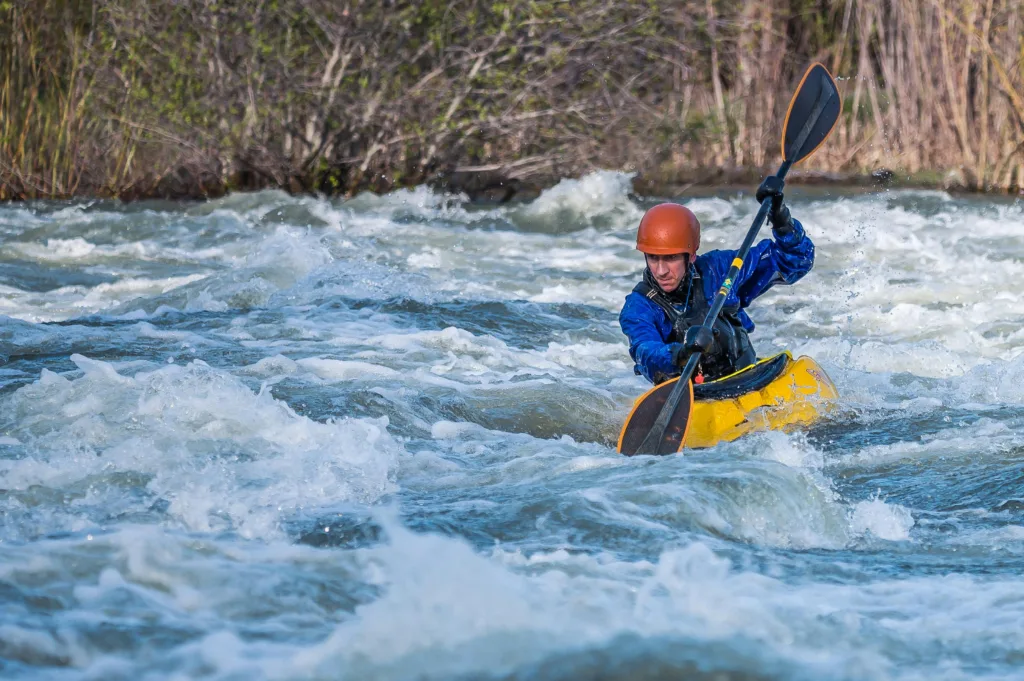
Kayaking Techniques and Tips
Mastering basic kayaking techniques is essential for a safe and enjoyable experience on the water. What is kayaking, encompasses not just the act of paddling but also the art of maneuvering the kayak with skill and precision. Here are some fundamental techniques and tips:
- Paddling Techniques: Proper paddling involves using your torso rather than just your arms. This technique, known as torso rotation, enhances power and endurance. Keep your strokes smooth and consistent, and practice paddling on both sides to maintain a straight path.
- Maneuvering: Learning to steer and turn your kayak effectively is crucial. Techniques like the sweep stroke (for wide turns) and the rudder stroke (for minor direction adjustments) are foundational. Practicing in calm water can build your confidence before moving on to more challenging conditions.
- Capsize Recovery: Knowing how to right yourself and re-enter your kayak in the event of a capsize is a vital safety skill. Practice the wet exit and re-entry techniques in a controlled environment with assistance.
- Safety Tips: Always wear a PFD, regardless of water conditions. Be aware of the weather and water temperatures, and avoid paddling in conditions beyond your skill level. Lastly, stay hydrated and protect yourself from the sun.
Popular Kayaking Destinations
From tranquil lakes nestled in mountain landscapes to the exhilarating rush of river rapids, the world is full of incredible kayaking destinations. Some of the most renowned include:
- Sea of Cortez, Mexico: Offers clear waters, abundant marine life, and beautiful beaches, ideal for sea kayaking and snorkeling.
- Milford Sound, New Zealand: Known for its dramatic fjords, waterfalls, and wildlife, it’s a paddler’s paradise.
- The Amazon Basin: Explore the world’s largest rainforest and its vast network of waterways, teeming with unique flora and fauna.
- The Dalmatian Coast, Croatia: Features stunning coastline, historic sites, and clear Mediterranean waters perfect for exploration by kayak.
- Alaska’s Inside Passage: Offers rugged beauty, glaciers, and a chance to see whales and other wildlife up close.
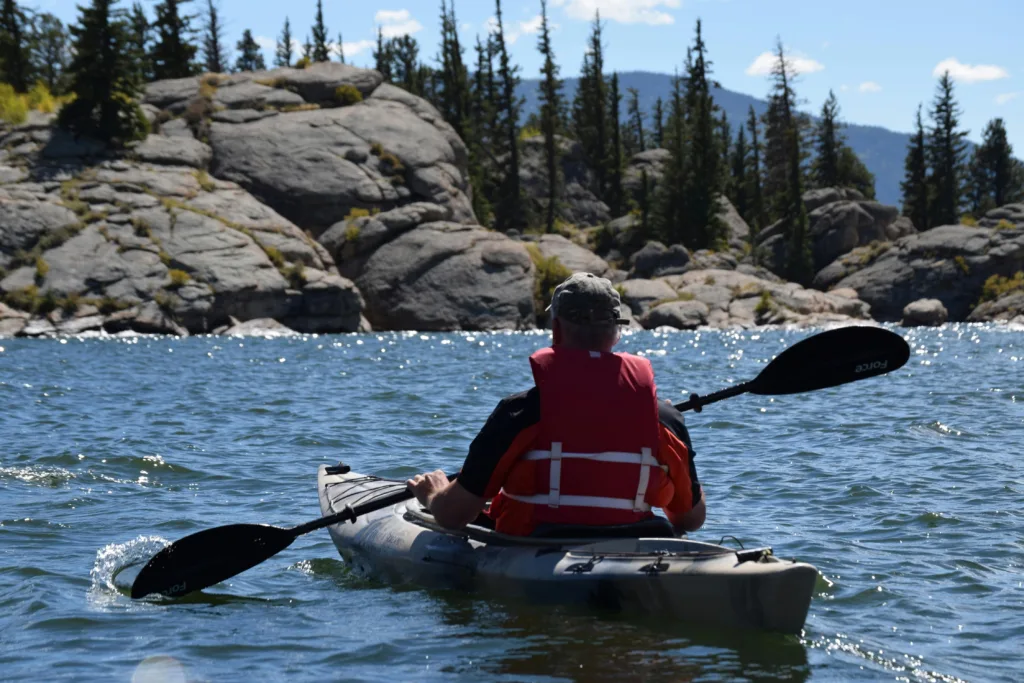
What is Kayaking: Conclusion
Kayaking stands as a testament to the adventurous spirit, offering a unique blend of tranquility, excitement, and connection with the natural world. From the peaceful solace found on a quiet lake at dawn to the adrenaline rush of navigating whitewater rapids, kayaking is a sport that appeals to a wide range of enthusiasts. It challenges the body, soothes the mind, and nurtures the soul. Whether you’re a seasoned paddler exploring uncharted waters or a beginner taking your first stroke in a local pond, kayaking invites you to immerse yourself in the beauty and serenity of the waterways.
As we’ve discovered, understanding what is kayaking is just the beginning. The true essence of kayaking unfolds with each paddle stroke, revealing a world of adventure, fitness, and camaraderie. So, grab your paddle, venture forth, and let the waters be your guide to the extraordinary experiences that await.
Discover the Best Time to Visit Barbados for Sunshine and Festivals
FAQs
What is the best type of kayak for beginners?
For beginners, stability and ease of handling are paramount. Recreational kayaks, which are wider and have a larger cockpit, are ideal for starters. They’re suited for calm waters like lakes and slow-moving rivers, offering a comfortable and forgiving introduction to kayaking.
How do I choose the right paddle?
The choice of paddle depends on your body size, strength, and the type of kayaking you plan to do. Generally, a lighter paddle with a length appropriate to your height and the width of your kayak will reduce fatigue and improve maneuverability. For recreational kayaking, a paddle around 220 to 230 cm is typically suitable for most.
Is kayaking safe?
Kayaking is relatively safe, especially when proper precautions are taken. Wearing a Personal Flotation Device (PFD), knowing how to swim, understanding basic rescue techniques, and being aware of weather and water conditions are crucial safety measures. Beginners should start in calm, shallow waters and gradually progress to more challenging conditions as their skills improve.
Can kayaking be a good workout?
Absolutely! Kayaking is an excellent full-body workout that primarily targets the upper body, core, and cardiovascular system. It can improve strength, endurance, flexibility, and balance. Because it’s a low-impact activity, it’s suitable for people of all ages and fitness levels.
How do I get involved in the kayaking community?
Getting involved in the kayaking community can be as simple as joining a local kayaking club, participating in group outings, or engaging with kayaking forums and social media groups. Attending kayaking workshops, events, and festivals is another great way to meet fellow enthusiasts and learn more about the sport.
